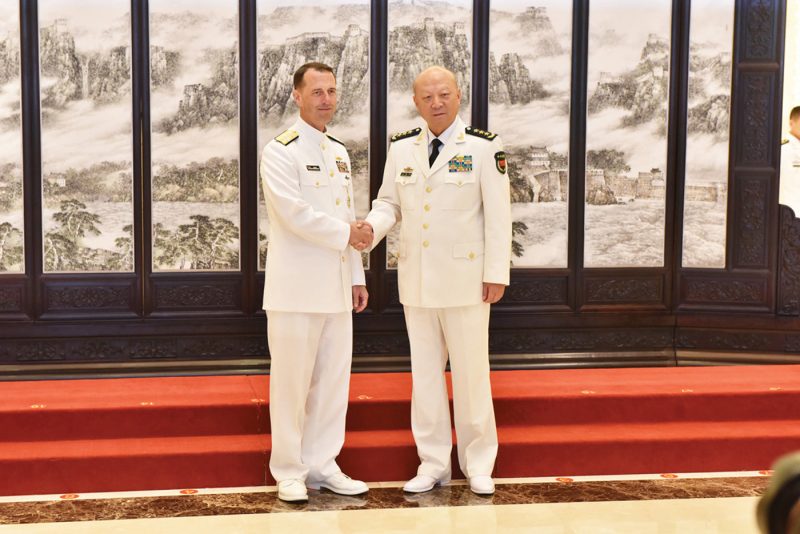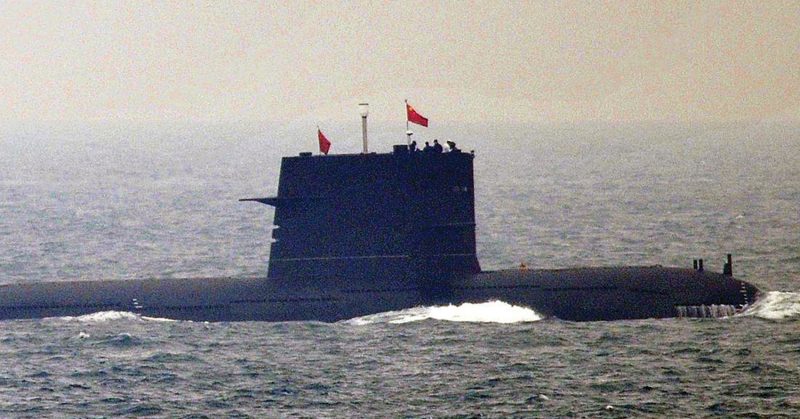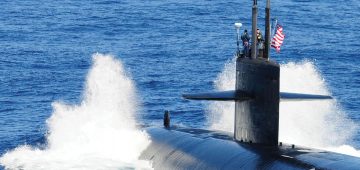Featured picture: The Chinese frigate Hengshui and destroyer Xian lead a multinational task group during RIMPAC 2016. Photo: US Navy.
As China reaches for true globe-girdling great power status, the new generation ballistic missile submarines of the People’s Liberation Army Navy (PLAN) are a key element.
Just as the Soviet Union strove in the 1970s and 1980s to make the Arctic a bastion for its own SSBNs, so the PLAN today wishes to cordon off the deep waters of the South China Sea in which to hide its ‘Bombers’.
The coral islands and reefs China has seized control of and swiftly turned into naval fortresses – host to airstrips and berths for warships – are to project Beijing’s ownership over a vast area of ocean.
China will soon create a Sound Surveillance System (SOSUS) cordon, constructing listening posts on the fortress islands to ensure that no intruding US Navy or allied submarines can operate in the South China Sea undetected.
It will then send its Shang Class attack boats (SSNs), advanced diesel-electric submarines and increasingly powerful and numerous Anti-Submarine Warfare (ASW) patrol vessels, plus surveillance aircraft, to counter trespassers. It means the new Jin Class vessels, which resemble Soviet-era Delta Class boats, do not need to be as quiet as SSBNs in the US, UK, Indian, Russian and French navies.
It is acknowledged that the Jin Class lack stealth, so this seems to be the solution to keeping them secure. They need never stray out of the threat-free bastion of the South China Sea while their JL-2 Submarine-Launched Ballistic Missiles (SLBM) will still be able to hit the cities of putative foes.
Many defence analysts increasingly see that as the major driving force behind Beijing’s actions in the South China Sea. Not even an international ruling that warns the Chinese their attempted annexation of islands and reefs is a blatant violation of international law will deflect them.
China’s immediate response to it was a spectacular firepower display by the PLAN in the contested seas, while announcing an equally ambitious joint exercise with Russian Navy units for this autumn.
The ruling by the Permanent Court of Arbitration (PCA) at The Hague was itself prompted by a dispute between the Philippines and China over ‘the role of historic rights and the source of maritime entitlements in the South China Sea’.
The PCA was asked to give its opinion on the issue in the context of Annex VII of the United Nations Convention of the Law of the Sea (UNCLOS), particularly on ‘the status of certain maritime features and the maritime entitlements they are capable of generating, and the lawfulness of certain actions by China that were alleged by the Philippines to violate the Convention.’

China made clear to the PCA that it would ‘neither accept nor participate in the arbitration unilaterally initiated by the Philippines’. It was therefore never likely to pay heed and amend its doctrine of might is right, allied with possession of the reefs and islands justifying its own claim to the entire South China Sea.
China has produced a so-called ‘nine-dash line’ to show the waters it considers are its own, but the PCA concluded there was ‘no legal basis for China to claim historic rights to resources within the sea areas falling within the “nine-dash line”.’ Furthermore, in reaching its verdict the PCA tribunal, noted that ‘although Chinese navigators and fishermen, as well as those of other States, had historically made use of the islands in the South China Sea, there was no evidence that China had historically exercised exclusive control over the waters or their resources.’
The Chinese were having none of it. Foreign Ministry Spokesperson Lu Kang poured scorn on the PCA ruling: “The arbitration case is nothing but a political farce that is illegal. Our territorial sovereignty and maritime rights and interests in the South China Sea, which we are determined to safeguard, will not be affected a bit by the ruling.”
When the US State Department made clear that it considered the PCA ruling legally binding on both China and the Philippines, Beijing’s fury was even more severe. “The US statement turned a blind eye to the facts and endorsed a ruling that is illegal and invalid,” pointed out Lu Kang. “Such [an] act went against the spirit of the rule of law, international law, basic norms governing international relations, and its declaration of not taking sides on issues concerning territorial disputes, obstructing efforts by relevant parties to properly manage and control maritime situation and peacefully resolve the disputes.”
Lu Kang accused America of hypocrisy. He said the USA is “selective when it comes to the application of international law”. For all the sound and fury emanating from the Chinese foreign ministry, the PLAN was still invited to send a task group to exercise with US Navy and other nations’ warships during Exercise Rim of the Pacific (RIMPAC) 2016.

Less than a week after the PCA ruling provoked such anger, the head of the USN, Admiral John Richardson, was holding talks in Beijing with his PLAN counterpart, Admiral Wu Shengli, and visiting Chinese warships in their homeports. Admiral Richardson explained during his visit: “I appreciate the opportunity to visit China and to meet with Admiral Wu in person. There is no substitute for these types of face-to-face meetings. My goal is to forge a relationship built on frankness and cooperation. Given the responsibilities that our navies have, we must work together and speak candidly – when we agree as well as when we have differing opinions.”
Admiral Wu was in public equally positive, saying that he was “very happy” to host the USN boss. “We attach great importance to your visit,” he told Admiral Richardson. “Your visit to China, at our invitation, shows how both sides put great priority on maritime issues.”
According to a USN source, the naval leaders had ‘frank and substantive conversations on the importance of operating safely, in accordance with international law; future opportunities for the two navies to engage; and the South China Sea.’ While the two admirals had previously engaged in discussion via video teleconferencing this was their first meeting in person and the first time the CNO had been to China.
As the talks concluded, China’s state media was reporting that during the behind-closed-doors discussions Admiral Wu told Admiral Richardson his nation would never “give up halfway” on its construction programme in the South China Sea. The English language newspaper China Daily also reported that Admiral Wu had stated China will not give in to international pressure and it has made “sufficient preparations” to deal with any attempts at provocation or incursions into areas of ocean it considers to be its sovereign territory.








Comments
Sorry, comments are closed for this item